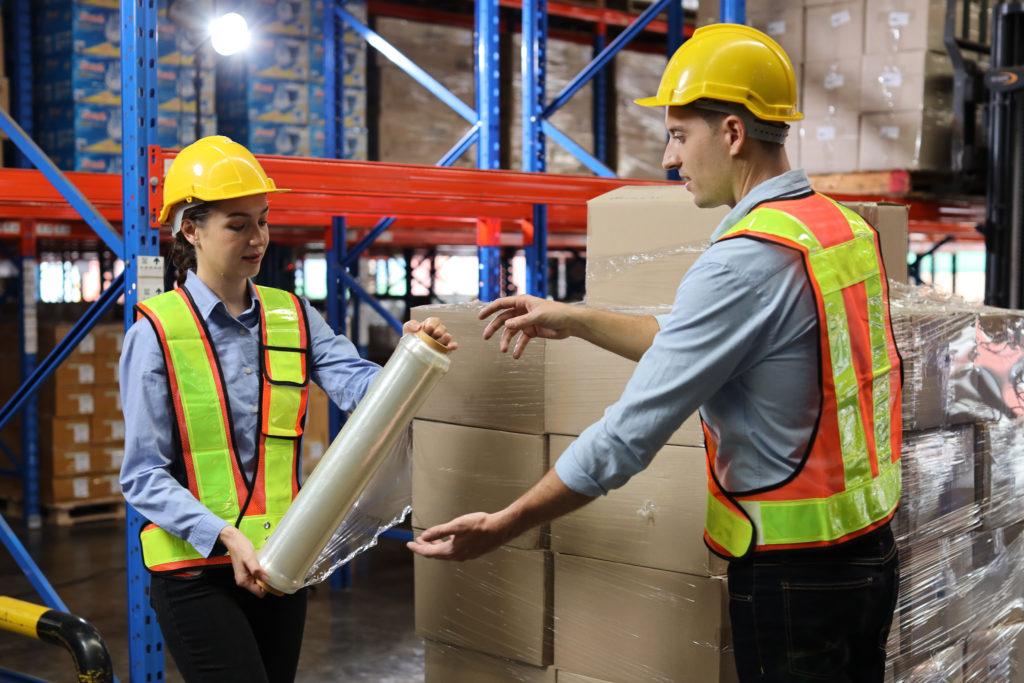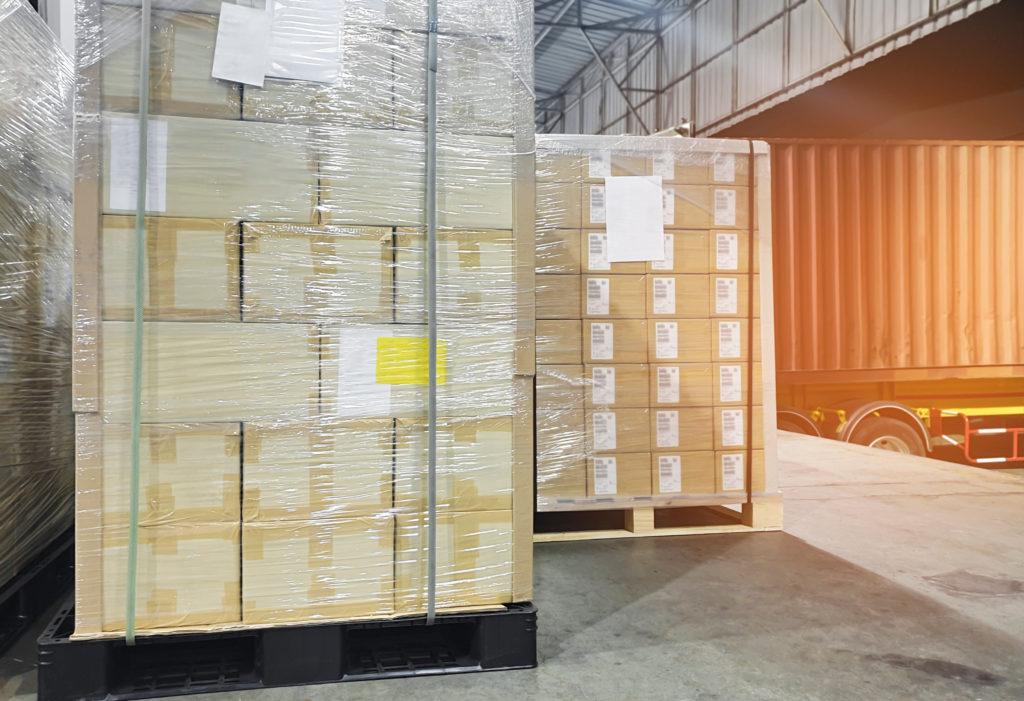There’s the right way to wrap your pallet by hand and there’s a wrong way to wrap your pallet. We’ll be explaining how to wrap your pallet correctly and safely.
But first of all, let’s start with why you need to wrap your pallet. It’s all about safety, that’s our number one priority. Yes, it’s even above on-time deliveries. Because if you don’t safely secure your goods to your pallet they won’t be making their full journey.
Ensuring everyone is safe, from our team to our customers to everyone around us is important and is our duty to our community.
“It’s a team effort to ensure the safety of our operations from our office team to our drivers to our customers. We all need to work together”
Richard Montgomery, MD of Mitchells
There are a few different ways to wrap your pallet before collection and delivery, our how-to guide will help you prepare your pallet of goods so they make it to their destination safely.
Contents

Tools you can use to wrap your pallet
Before you shrink-wrap your pallet ensure your goods have been correctly assembled on the pallet. You can see our guides on how to prepare a pallet for collection and pallet stacking patterns to help you. However, if you’re sending a hazardous item you’ll want to read our guide on shipping gear boxes and engines.
To ensure your pallet is extra secure before shrink-wrapping try using strapping bands to hold everything in place. Your pallet should feel secure and the weight should be evenly spread out across the pallet base.
1. Secure the shrink-wrap
Before you start wrapping, secure the wrap to the pallet by tying a knot. This will help when wrapping the pallet as it will provide tension and stop the shrink wrap from being loose.
2. Wrap from the base
Start from the base of the pallet and move around until the wrap securely covers the bottom part of your stacked pallet. This will ensure your base is secure as this is where most of the weight is.
Wrap around the base a few times before slowly starting to move upwards. Maintain tension while wrapping your pallet so to ensure your goods won’t be moving during transit. Allow there to be overlap between the levels when wrapping your pallet.
You’ll most likely be going round in circles so make sure to take it steady! We don’t want any dizzy customers when we come to collect your pallet.
3. Test your pallet wrap
When you reach the top of wrapping your pallet, test the strength and tension of your wrap. Do your goods feel secure? If not add some more layers of wrap. Don’t skimp on the wrap! The more you wrap, the more secure your goods will be.
4. Wrap the top of the pallet
Once you’re confident your pallet feels secure and your wrapping feels tight it’s time to wrap it up. Ensure the four corners of the pallet stack are covered and tear the wrap from the roll.
Using the loose end of the wrap, you can either tuck it away into a layer of wrap or secure it to the end of the pallet.

Tools you can use to wrap your pallet
There are a few tools to make shrink-wrapping your pallet easier. Many of these will be most often used in companies that regularly send pallets out for delivery. You don’t always need fancy tools to wrap your pallet as it can be done by hand but to make your life easier when wrapping pallets often here are a few options for pallet wrapping.
Shrink wrap
Shrink wrap is the invisible shield that keeps your palletised products safe and secure. This highly versatile film goes by many names – pallet wrap, stretch wrap, or simply stretch film – but its function remains the same: to bind and stabilise goods on a pallet for storage or transportation.
The magic of shrink wrap lies in its unique properties. Made from a special type of plastic, it possesses both high cling and superior strength. When applied with tension, the film stretches around the pallet, conforming to the shape of the load. As it recoils, it creates a constant force that holds everything tightly in place, preventing your goods from shifting or toppling during transport.
Shrink wrap comes in a variety of grades, offering different levels of puncture resistance, tear strength, and thickness. The ideal choice for your application depends on the weight and fragility of your products, as well as the anticipated transport conditions. For instance, heavier pallets or those destined for long journeys might require a thicker, more robust film compared to lighter pallets on short trips.
By choosing the right type of stretch wrap and applying it correctly, you can ensure your goods arrive at their destination in pristine condition. This not only protects your products but also minimises the risk of damage during transport, saving you time, money, and frustration.
Pallet wrap dispenser
The pallet wrap dispenser might seem like a simple tool, but it plays a crucial role in creating secure and efficient pallet wraps. A good dispenser offers several advantages:
Smooth and even application: A well-designed dispenser allows for effortless unwinding of the wrap, helping you maintain consistent tension and avoid tearing or bunching. This creates a neater, more secure wrap that uses less film.
Ergonomic design: Many dispensers feature handgrips and brakes to reduce strain on the user’s wrist and hand. This is particularly important for high-volume wrapping operations where fatigue can set in.
Tension control: Certain dispensers have built-in brakes or adjustable tension settings. This allows you to tailor the wrapping tightness to the specific load, ensuring stability for heavier pallets without overwrapping lighter ones.
Puncture resistance: Some dispensers come with a built-in puncture tool. This helps to safely cut the film without accidentally damaging the roll, saving time and minimising wasted wrap.
With a good pallet wrap dispenser in hand, you can transform this task from a laborious chore to a smooth and efficient process.
Heat sealers
For an extra layer of security and protection, especially for products vulnerable to moisture, dust, or tampering, heat guns become the ultimate finishing touch in the pallet wrapping process. These handy tools utilise heat to create a tamper-evident seal on the stretch wrap, ensuring your goods remain undisturbed throughout their journey.
Heat sealers typically come in handheld formats, offering portability and ease of use. They function by pressing a heated bar against the overlapping layers of stretch wrap, effectively melting them together to form a secure bond. This creates a barrier that prevents dust, moisture, or even prying hands from accessing your goods.
There are a few key factors to consider when choosing a heat sealer:
- Seal Width: The width of the sealing bar should correspond to the thickness of your stretch wrap for optimal results.
- Temperature Control: Some sealers offer adjustable temperature settings, allowing you to tailor the heat to the specific type of stretch wrap being used. This helps prevent burning or damaging the film.
- Cool Down Time: The time it takes for the sealing bar to cool down after use can impact workflow. Opt for a sealer with a quick cool-down period to maintain efficiency.
While not essential for every shrink-wrapping operation, heat sealers provide significant benefits for specific situations. They offer enhanced protection for sensitive products, deter tampering, and create a more professional presentation for your palletised goods.
The ideal tools for your operation will depend on your wrapping volume, budget, and specific needs. By having the right pallet wrapping tools, you can ensure your products arrive at their destination safely and securely.
Shrinkwrapping FAQs
- How big is a standard pallet?
A standard pallet is 1.2m x 1.2m base x 2.2m high.
- How much can a pallet hold?
The maximum weight for pallet tail lift delivery is 1,000 KGs, however, this can be increased to 1,200KGs prior to your collection by arrangement with our team.
- How much shrink wrap per pallet?
This can vary depending on your pallet size and pallet loads. On a standard pallet, you should be using around 54 metres to safely wrap your pallet.
- Do you wrap or strap a pallet first?
You should add safety straps to your pallet before you wrap your pallet.
- How many times should I wrap a pallet?
You should aim to wrap your pallet 4 to 5 times. But this depends on your goods and load stability.
- Do you offer a pallet and wrap service?
Yes, we can collect goods and wrap them (only). This will incur a surcharge. Please note that wrap is only a weather protection and does not act as a suitable product to secure the goods to the pallet base. Contact us to arrange this service.